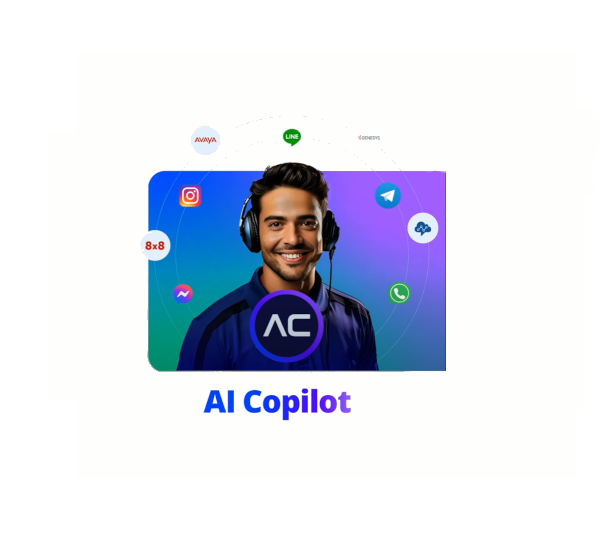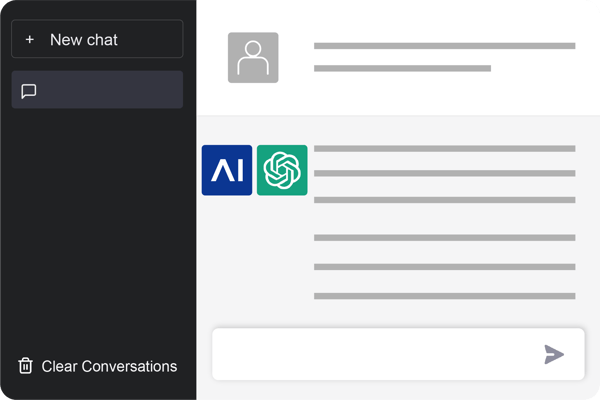Though it pays to be skeptical about new technology, there comes a point when value and utility become too compelling to ignore.
For AI and its potential within a contact center business, that point is already here.
In an industry that relies on improving both resource efficiency and customer experience, AI has the potential to make clear, tangible impacts on many of your most well-defined use cases.
From cutting down on long call waiting times to improving satisfactory customer interactions, AI Agents built with Conversational AI and Generative AI play a pivotal role in driving performance improvements in the areas crucial to contact center success.
Seeing is believing, so let’s talk about some of the most important AI use cases within contact centers…
Related content:
- What is an AI Contact Center?
- Contact Center vs Call Center: What's the difference?
- Generative AI in Enterprise Contact Centers: A Complete Guide
- Omnichannel vs Multichannel in Contact Centers: What's the difference?
Introduction to AI in Contact Centers
When your business depends on resolving calls quickly and effectively, AI promises to revolutionize the most time-consuming and inefficient workflow processes, whether creating call transcripts or engaging in customer-facing voice or text chat.
AI systems have vast potential, but capabilities depend solely on how willing you and your team are to embrace the technology and progress through a maturity model. When you first adopt a system, you’ll tackle basic tasks before maturing into more technical (and more valuable) use cases.
AI’s Evolving Role in Your Business
- 1: Foundational support: The most basic ‘phase’ of using AI involves basic tasks such as transcribing customer phone calls and other surface-level processes that don’t require much customer-facing interaction.
- 2: Automation and augmentation: At the next stage, Generative AI and Conversational AI can be deployed to augment your existing processes and provide useful automation, which generally involves redesigning a task entirely. For example, utilizing Conversational AI to automate Identification & Verification processes.
- 3: Transformation: Once AI is an active part of your core processes, it will begin to learn from customer interactions and operational data. You’ll now have a context-ready AI agent to empower your human agents. It can recognize a customer’s problem and either automatically solve it where possible or route the call to a human agent.
These stages are not fixed because every business is different, but they do help illustrate the varying levels to which AI can be used within a contact center and how the value only grows as your adoption matures. Even an AI tool that automates your most basic, foundational tasks can generate great ROI.
Of course, it’s easy to tell you that AI is great in contact centers and capable of driving significant results at every stage. To better understand its efficacy, it’s time to explore some real-world use cases so that we can show you.
The Most Effective AI Contact Center Use Cases
If you’re interested in unlocking the power of AI Agents within your contact center, you need to identify the specific use cases that AI can help with. At this early stage, you may struggle to do this because you haven’t actually seen what an AI agent is capable of.
That’s why it’s a good idea to explore some generic use cases built around the common challenges most contact centers encounter. In all of these examples, the fundamental ‘system’ behind the AI is the same – the role that the AI plays changes depending on which processes you apply it to.
With that in mind, here are some of the most compelling use cases for AI within a contact center environment…
1) Call Monitoring
By combining STT (speech-to-text) with AI, you can create a solid call monitoring solution. This is a passive task because the AI isn’t changing anything or interacting directly with anyone. However, it is still one of the most valuable in terms of time savings and cost-efficiency, which mostly come from reducing the labor burden on your human team.
To say AI is simply transcribing a call is a gross understatement. AI takes a far more active role in even this passive task, using Generative AI and Conversational AI to understand the caller’s intent, analyze their sentiment, and create a summary afterward.
Though even this basic AI role can deliver big performance improvements to your contact center, the benefits don’t stop there. Your AI will retrieve text from an STT system then analyze it to recognize intent and begin making suggestions. It can also generate insights such as sentiment analysis to be used in reporting.
For example, if the AI detects a query in a customer’s call, it can generate an answer or appropriate resource which is sent to the agent in real-time, dramatically speeding up favorable resolutions.
Why use an AI Agent for call monitoring?
- Automatically transcribes calls in real time.
- Can create summaries or logs in any format or template you require
- Understands context, intent, and user sentiment
- Can take follow-up actions such as routing a query to an agent
In action:
In a UK-based insurance provider’s contact center, human agents were tasked with creating call summaries. Even using a pre-defined format and minimizing labor requirements, the task still took between 5-10 minutes after each call.
The agents were under constant pressure to resolve calls and move on to the next customer, so this logging task was viewed as a chore and was often either done poorly or ignored entirely.
By incorporating an AI Agent into their team, the insurance provider was able to remove this manual burden from the human agents. The AI monitored every call and summarized them in the required format in a matter of seconds. The agent would then perform a quick final check before storing the log.
Not only did this improve agent satisfaction, but it also improved overall productivity and utilization because agents were saving valuable minutes per call. The AI Agent’s summaries, which included sentiment analysis, then acted as a valuable resource for the management team to review overall performance.
2) Identification & Verification (IDV)
Identifying the customer, determining their problem, and verifying personal information is essential in every customer interaction. However, this process wastes valuable time and frustrates everyone involved.
An AI agent tasked with performing IDV can eliminate initial waiting times and immediately begin verifying a user. 33% of customers report that their biggest frustration is waiting on hold, which shows why having an AI Agent that can reduce waiting times to zero is appealing.
How you use AI to change your IDV process will depend on your organization. A contact center can often utilize an AI-powered chatbot to take a user through basic IDV without them even making a call. This empowers the user AND reduces total call volume and pressure on agents.
Chatbots are far from the only application. You can also deploy an AI Agent that uses Conversational IVR to field live customer calls. It can take a user through the initial verification process and then recognize context and intent to either resolve a simple task automatically (such as a password change or address update) or elevate the call to an agent.
Using this system, your customers don’t have to wait on hold before they reach the agent, and all of the ‘mundane’ steps are already taken care of. The AI Agent will provide all of this information to the agent before they even answer the call, so your human employees never have to risk frustrating customers with the same dull question… “May I ask the reason for your call?”
With AI Agents handling IDV, you vastly improve the chance of a satisfactory outcome. If the customer’s request is simple and related to IDV (such as changing a password or updating an address), AI can handle it automatically – which means no waiting times or long calls.
If it’s more complex, the AI agent will perform the basic verification steps and determine intent before sending the customer to the most appropriate agent, which cuts down on internal transfers and improves overall agent productivity.
Why use an AI agent for IDV?
- Automate the steps behind your important (but boring) verification process
- Reduce customer waiting times
- Empower agents by removing manual verification and providing information about a caller’s intent
In action:
A contact center for a global banking brand headquartered in the USA was overwhelmed by customer call volume. Due to the sensitivity of personal information in the banking industry, every call began with agents taking customers through a 45-second verification process.
Because agents were busy performing this IDV process, customers were being placed on hold for significant lengths of time.
The company introduced a Conversational IVR Agent to combat this issue, and the results were immediate. The agent reduced waiting times to zero and could immediately begin the IDV process. Crucially, it could recognize a caller’s intent, create relevant responses, or carry out the appropriate action.
With just this step in place, the contact center's call burden was slashed. Most customers with basic requests reach an outcome without ever interacting with a human agent. Those whose calls did need human intervention didn’t have to wait as long or repeat their issues to get the support they needed.
3) Language Offshoring
If your customers don’t speak your language, how can you help with their problems? Hiring translators or native speakers isn’t usually practical OR cost-efficient.
Using an AI is the only effective way to create a multilingual contact center that you can scale. An AI that utilizes Natural Language Understanding and Conversational AI can not only understand multiple languages but also navigate through the natural quirks and issues that crop up during real conversations. Unlike human agents, AI is a 24/7 solution, so time zones have no impact on its effectiveness.
Cognigy.AI’s solution combines pre-trained NLU models and LLM data to provide an AI Agent capable of translating existing processes or flows when you want to launch new localizations. The agent can also engage in real-time conversations with customers and provide live translation for agents during the call.
AI Agents give you a cost-effective way to offshore languages. Rather than undergoing the costly and complex process of securing a contact center filled with staff speaking your destination country’s language, your AI Agent can be quickly trained from existing resources and deployed to provide 24/7 support.
In action:
A major telecommunications provider that served a market of almost 5 million customers in a country with its own language that isn’t widely spoken anywhere else. The niche nature of this language means many dedicated NLU models might have struggled, but the AI was instead trained using a universal language model.
After this dedicated training, the AI agent could interpret and converse in this language to plug the company’s significant labor gap. Now, customers in that country could make contact and converse in their own language—whether that was to perform simple self-service tasks or for the AI to route the call to an agent and provide live translation during the call.
5) Upselling and Sales Support
The old motto that governs sales is ‘people buy people,’ and contact centers often find that to be true. When a customer call becomes a sale opportunity, it’s usually due to the agent's efforts and direct interaction with the customer.
Though the power of Conversational AI and Generative AI combined into an AI agent would theoretically allow for an AI to promote offers and pursue upsells, the real potential is in combining AI with human agents to help maximize sales opportunities.
In a contact center environment, sales can take a complex route depending on whether you’re handling an outbound or inbound call and what your customer’s background and problem might be. A customer calling because they’ve run out of mobile data, for example, may be receptive to an upsell package – but only if you can navigate their frustration and confusion at being cut off from the internet.
AI agents help create a more empathetic pathway to sell to your customers. After handling the initial IDV process, which already alleviates many of a customer’s main frustrations, the AI will display the appropriate background information to your human agent. The agent will then have a better understanding of the opportunity and be better able to target a sales opportunity.
The AI doesn’t stop there, however – it can also monitor the call and identify contextual information from across your database to display relevant resources and pull opportunities that it sends to your human team. For example, the AI could recognize a user’s existing phone plan and display upgrade plans for the human agent to utilize on the call.
Sales, like any process, relies on understanding a customer’s needs and eliminating frustrations or delays. AI Agents help facilitate this at scale, making your entire organization better equipped to sell.
In action:
A large Australian telecoms business struggled to grow its revenue despite engaging in dedicated sales training for its entire contact team. The team was expected to hit specific targets by engaging in upsells during customer calls.
However, because customers were usually calling about a problem and then having to wait on hold, perform verification, and make a complaint, they were not receptive to upselling. The team was growing more dissatisfied with its seemingly impossible targets.
After investing in an AI Agent, the business transformed the upsell process by automating the entire IDV process. This meant reduced call waiting times and gave the agent all the background they needed right from the start of the voice call. The AI Agent would also provide live support to issue offers and plan details directly to the agent’s screen.
Now powered by AI, the telecoms business has realized its sales ambition, generating enough revenue to help them grow considerably and expand into new territories.
6) Problem-solving
You might think of problem-solving as a ‘basic’ feature. After all, Google can often give you the answer – why would you need AI?
The reality is that for contact centers, where a customer’s issue is pressing to the point of urgency, you need your team to be able to reach a competent resolution as soon as possible – without relying on generic resources like Google, which aren’t relevant to your service or products.
Using a digital knowledge hub that agents have to search during a call manually isn’t as straightforward as using an AI Agent as a problem-solving solution. With its ability to listen to calls in real time, the AI can identify queries and search your database for the correct answer—all in a matter of seconds. Some AI Agents can also utilize Automated Image Analysis, which allows them to extract data from digital images such as order receipts.
This means you’ll be able to resolve user queries at the self-service stage wherever possible. If a query is too impactful for the AI to deal with independently, it will find the most appropriate agent for the problem. This cuts customer wait times, minimizes the risk of a customer being transferred to an agent who can’t help them, and ultimately speeds up effective outcomes that lead to happier customers.
In action:
A prominent retail client found that customer queries around order status, shipping details, and product information were slowing down their team.
They began working with Cognigy.AI to streamline the customer contact process and make it easier for customers to find solutions to their problems without ever speaking to a human—though a call could still be routed to an agent if necessary.
The brand created a personalized virtual assistant powered by Conversational AI. It acted as the first point of contact for all customer queries and could either resolve them or flag the right agent. This dramatically reduced resolution times from 10 days down to just 15 seconds.
Better yet, thinking back to the upselling use case, this AI Agent also helped supercharge conversion rates by providing personalized shopping support. Following its deployment, the company enjoyed a growth in conversion rate of 200% year-on-year.
Bonus Use Cases
The use cases we’ve just covered are only a sample of the capabilities AI can bring to your contact center. There are many more, including:
- An AI-powered retail chatbot that funnels users towards purchases and smooths out the buying journey
- Automated QA or testing process using an AI that performs the tasks and makes detailed logs for future review
- Store and review actionable insight from all calls and conversations, with data including key factors like customer sentiment, specific keywords, and common queries/issues.
The Future of AI Contact Centers
AI is not here to replace existing human agents. It is designed to augment your team and improve the entire customer support experience from first contact to resolution.
Though this guide has covered some shared use cases, many new use cases will be developed as new problems, challenges, and opportunities arise.
Due to AI's learning abilities, your technology will grow with you, and may even find new ways to accomplish tasks unique to your team. Businesses embracing AI now are better positioned to reap the rewards as the systems mature.
A European passenger airline recently experienced this when its AI chatbot was struggling due to excessively long customer input, which covered a variety of issues (and not always relevant ones!).
Once they identified this issue, the team deployed Generative AI to identify these queries, summarize them in a more useful format, and pass them back to the NLU – all without any need to contact the customer and ask them to refine their query.
This example helps demonstrate that businesses can deploy AI agents in evidenced, commonly shared use cases and novel applications, which, when successful, will eventually become future use cases.
If you have a use case in mind you think AI could support your team with, request a demo of Cognigy.AI and see how artificial intelligence can revolutionize your contact center.

.png?width=60&height=60&name=AI%20Copilot%20logo%20(mega%20menu).png)




.png?width=600&height=600&name=Knowledge%20AI%20Feature%20image%20(2).png)













